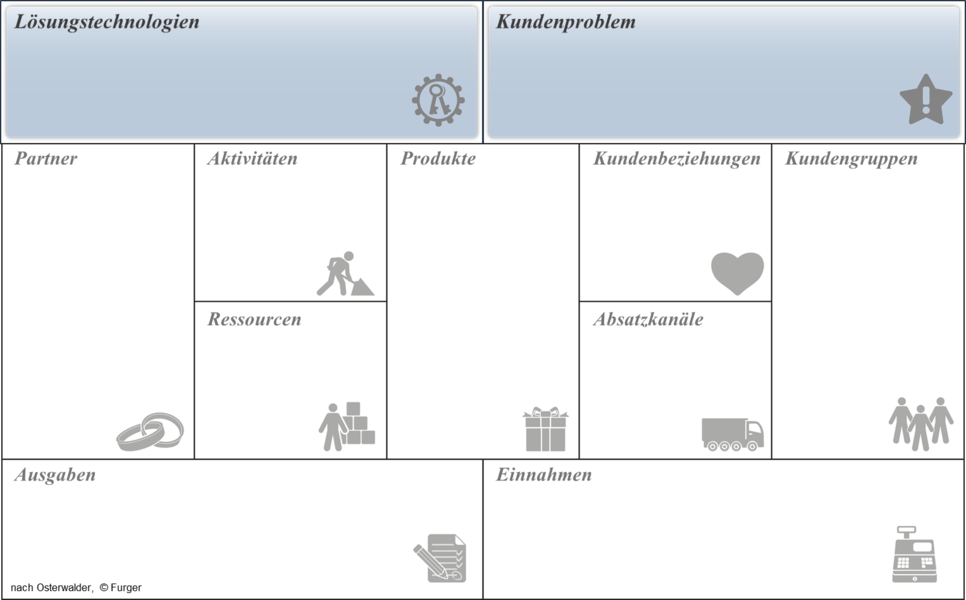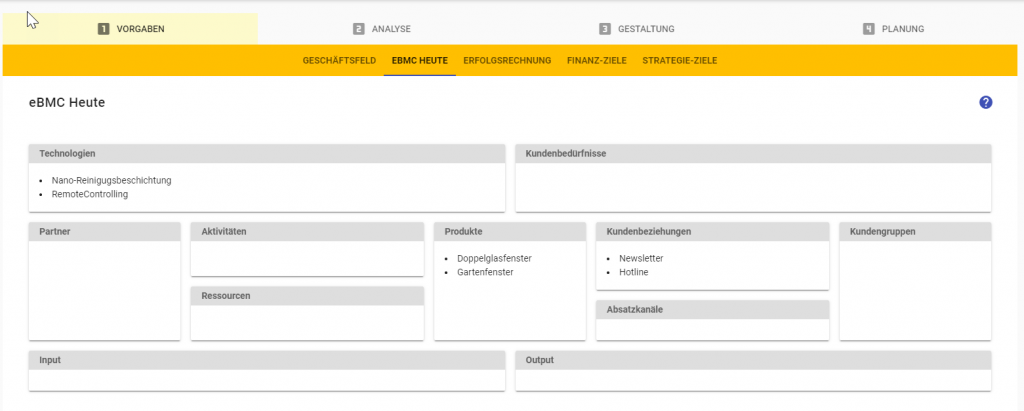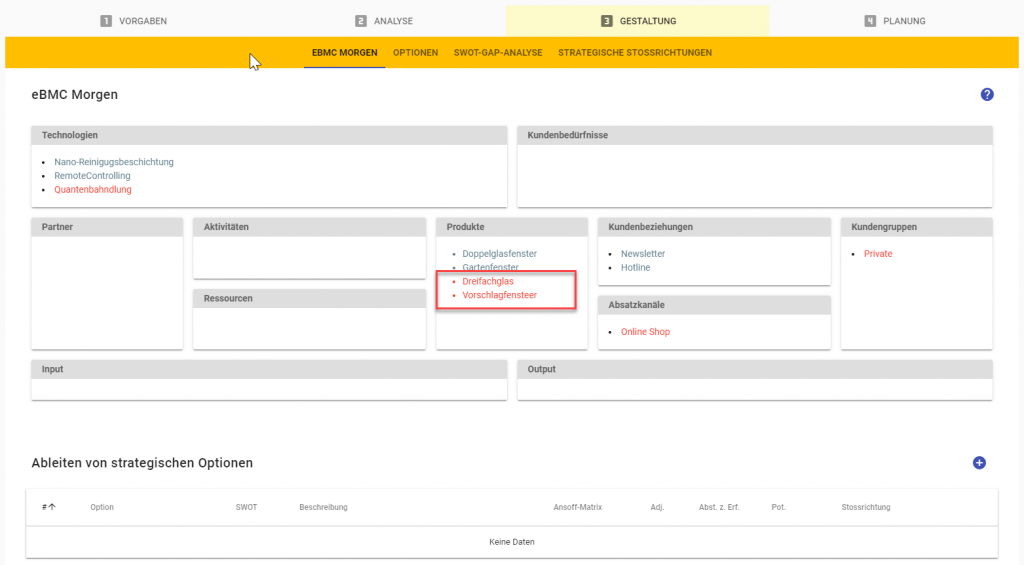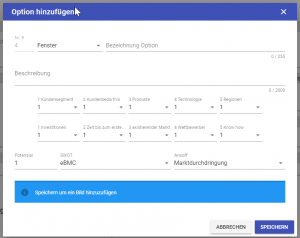Ihr Warenkorb ist gerade leer!
White Paper Innovation Management with the «Extended Business Model Canvas» (eBMC)
From the BMC to the eBMC
If you compare the Business Model Canvas with the navigation system of Aloys Gälweiler, you will see that the innovation is positioned there on the top level, with the two components «solution-independent customer problem» and «solution technology». We then put these two building blocks on the Business Model Canvas, making this extended Business Model Canvas (eBMC) a great tool for innovation management.
The book «Business Model Generation», published by Alexander Osterwalder, has hit the world of consulting and entrepreneurs like a bomb. The book is practical, very nicely done and above all very different from anything else in the field. And success proves the author right.
When a colleague told me about this model for the first time, something irritated me from the beginning – something was missing. It’s not like the BMC reinvented the world. Much can be found in it from known approaches and methods – or not.
What was lacking for me from the beginning is the building block «customer problem», namely the «solution-independent customer problem», as we used to call it. Based on the St. Gallen approach, we have always clearly separated the customer problem from the product or service itself.
The «Solution-Independent Customer Problem»
A watch is a product for the purpose of indicating the time. The customer problem, namely the time to know, however, is independent of the clock and can be solved differently. This applies even more clearly when the watch is offered as a luxury or status object. Then the customer problem is to make a difference, and that can be solved with completely different offerings or value propositions.
In the BMC, the customer problem is presented together with the building block product and then called «value offer» in New German. Later, a separate canvas was developed for the building block customer problem and with the help of the so-called empathy card (by Xplane).
I did not let this thought go, and I studied how the canvas model can be complemented with the customer problem without destroying the model’s logical unity and symmetry. And as is sometimes the case, the best thoughts come when you are alone: During a long run through the forest, I had the following idea: Let’s take the top level of the navigation system of Aloys Gaelweiler with the two components «solution-independent customer problem» and «solution technology,» and put them on the business model canvas. This makes this enhanced Business Model Canvas (eBMC) a great tool for innovation management.
This results in the following chain: customer – customer problem – technology – product or if you prefer: product – technology – customer problem – customer. The interesting thing is that the model remains nicely symmetrical and fits together logically.
Innovation Management with the eBMC
Supplemented with the two building blocks from Gälweiler’s navigation system, we use the canvas model mainly in the search for new businesses. This makes it an excellent instrument for innovation management. Because innovation can be driven forward from two sides: the market and the technology. Good practical instructions have been provided by Prof. Hugo Tschirky, who teaches at ETH Zurich, with his approach to innovation management. We find it in the book « Wunderwaffe Innovation «by Beat Birkenmeier and Harald Brodbeck. In the following, we will explain the two components «customer problem» and «solution technologies» in more detail so that you, too, can supplement the Business Model Canvas accordingly and use it as an innovation tool

The module «customer problem»
This component stands for the customer problem that a company wants to solve – and that is about the «solution-independent customer problem». This means that this customer problem is often latent and is only solved differently and better by new products or services.
Here is an interim remark: We use the terms «customer problem» – «customer need» and «customer request» as synonyms. You are free to use your appropriate term here.
Solving a customer problem brings benefits to the customer, and it is for this benefit that the customer is ready to pay. So the product «car» is not primarily a beautifully designed machine on four wheels, but creates the ability to move from A to B at any time. It is often useful to abstract a business idea to this «problem» in order to come up with new solution techniques. Innovation, which is based on the market, is mainly concerned with it and can only work if you know the original customer problem exactly.
These may be a original problem as such like eating and drinking or secondary, derived problems such as luxury goods, holidays or other amenities that go beyond a basic elementary need.
The most important questions about this module:
- Which customer problem do we want to solve or which customer needs do we want to satisfy?
- What does the customer really pay for?
- What is the background of a problem solution?
- What are the real purchase criteria from the customer’s point of view?
- Which purchase criteria are better covered by our products?
- What brings the customer to put the money on our counter instead of the competition?
Instrument Customer Value Analysis (Value Proposition)
The customer value analysis is probably the didactically best instrument to focus the company in its activities on the customer benefit. The instrument can be set up directly on the building block customer problem. This creates the logical and substantial connection between customer benefit – products – customer groups.
On the basis of purchase criteria, a strategic Value Map is created that shows which competitors bring benefits to the customer with their products. For a detailed description, the tool itself, and the tutorial, see the white paper Customer Benefits on our BLOG
The module «Solution Technologies»
This component represents the technical solutions behind a product or service. Technologies usually have a specific lifecycle and, after a certain period of time, are replaced by new technologies that solve a customer problem better and more favorably. Thus, a substitution process begins, which leads to the replacement of existing products in the market. This process normally follows the pattern of an S-curve.
An example of this is the substitution of horse-drawn carriages by automobiles. Innovation always takes place in the interplay between the knowledge of the original customer problem and new solution technologies. The timeframe of substitution varies and can go on for years. The first presentation of a new solution concept is called invention, while innovation only exists when the product prevails in the market. Solution technologies can be incremental improvements or implement completely new concepts like the laser printer or the fax technology that has substituted the telex. Such completely new approaches often turn the existing business model upside down, which is described by the term «disruption».
The most important questions about this module:
- Which existing solution technologies are behind the products?
- In which phase of life are these technologies?
- Where are new inventions, and which customer problems can be resolved (much) better?
- Where and in which technologies does our company have competencies – a lead over the competition and therefore core competences?
- For which purchase criteria can we make significant improvements?
Instrument substitution analysis (S-Curve)
With the substitution analysis, the replacement of existing products or technologies by new offers can be shown.
This instrument helps on three levels:
- to find the optimal time to enter a new market (or exit)
- To set the growth rates in growing markets against the market and the competitor.
- To plan the transition to a price or cost market, and thus to exploit the cost position or to withdraw from the market.
eBMC in the STRATEGY.APP
For each business area, we create the eBMC with the current key elements. Each module is filled accordingly and can be adapted, printed or otherwise communicated at any time:

The individual blocks and elements are entered in the usual editing window:

In the design phase, we can now add additional key elements; here e.g. as a new technology, the «nanotechnology» applied to the coating of the glass; or a new sales channel with which customers will be served in the future:

The new elements appear in red for identification. This provides us with a basis for deriving new strategic options and developing strategic directions and measures.

These are then listed in parallel with the options derived from the SWOT.
Here, too, options can be added, added, stopped or deleted at any time.
Schreiben Sie einen Kommentar